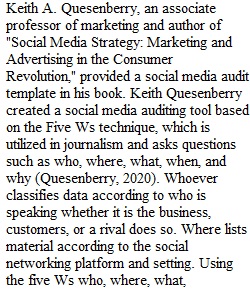


Q Hello Everyone, The final project for this class is for you to select a company for whom you will conduct a social media audit. The material that you are learning during our course will prepare you to successfully complete this assignment. For this assignment, please read and absorb the information contained in the article below. Please chose how you'd like to demonstrate to me your understanding of this information. If you'd like to write a paper, please use a 250-300 word guideline. If you'd like to record a video of yourself presenting your understanding of this information, this works as well. If you would like to dictate your understanding of this information using the voice record of a smart phone and sending me this recording, this works, too. My goal is for you to read, absorb and digest this information and to illustrate to me that you understand it. The communication channel that you use to share your understanding with me is up to you. Please let me know if you have questions. Thank You. Prof. Noonan The Ultimate Guide to Conducting a Social Media Audit
View Related Questions